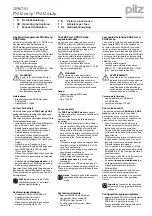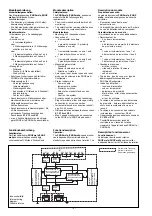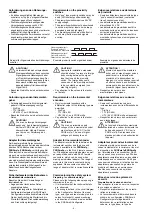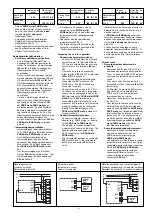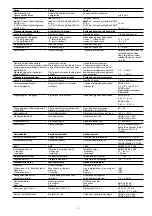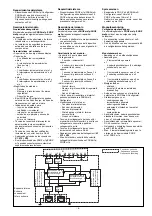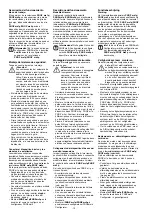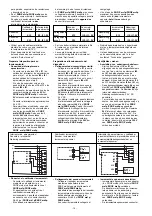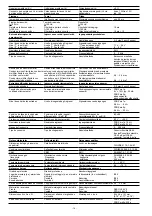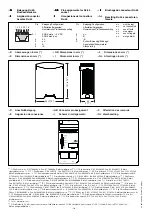
- 3 -
Drehrichtung überwachen. Das
PNOZ ms1p/
PNOZ ms2p
meldet den Status der über-
wachten Werte an das Basisgerät. Abhängig
von der geladenen Sicherheitsschaltung
können die Werte vom Basisgerät z. B. an
einen Relaisausgang des Sicherheitssystems
übergeben werden.
Für die Aufnahme der Werte können
Inkrementalgeber und/oder Näherungsschalter
eingesetzt werden.
Info!
In der Online-Hilfe des PNOZmulti
Configurators ist die Konfiguration des
Drehzahlwächters
PNOZ ms1p/PNOZ
ms2p
ausführlich beschrieben.
Sicherheitssystem montieren
Beachten Sie bei der Montage:
Achtung!
Durch elektrostatische
Entladung können Bauteile der
Sicherheitssteuerung beschädigt
werden. Sorgen Sie für Entladung,
bevor Sie die Sicherheitssteuerung
berühren, z. B. durch Berühren einer
geerdeten, leitfähigen Fläche oder
durch Tragen eines geerdeten
Armbands.
• Montieren Sie das Sicherheitssystem in
einen Schaltschrank mit einer Schutzart
von mindestens IP54.
•
Montieren Sie das Sicherheitssystem auf
eine waagrechte Tragschiene. Die Lüf-
tungsschlitze müssen nach oben und unten
zeigen (siehe Betriebsanleitung des
Basisgeräts PNOZ m0p, PNOZ m1p,
PNOZ m2p). Andere Einbaulagen können
zur Zerstörung des Sicherheitssystems
führen.
• Befestigen Sie das Sicherheitssystem mit
Hilfe der Rastelemente auf der Rückseite
auf einer Normschiene. Führen Sie das
Sicherheitssystem gerade auf die Norm-
schiene, so dass die Erdungsfedern am
Sicherheitssystem auf die Normschiene
gedrückt werden.
• Um die EMV-Anforderungen einzuhalten,
muss die Normschiene mit dem Schalt-
schrankgehäuse niederohmig verbunden
sein.
Basisgerät und Erweiterungsmodule
verbinden
Die Module werden mit Steckbrücken
verbunden. Es dürfen max. 8 Erweiterungs-
module und ein Feldbusmodul an ein
Basisgerät angeschlossen werden. Davon
sind max. 4 Drehzahlwächter
PNOZ ms1p/
PNOZ ms2p
zulässig.
Auf der Geräterückseite des Basisgeräts
PNOZ m1p befinden sich 2 Stiftleisten.
• Stellen Sie sicher, dass kein Abschluss-
stecker gesteckt ist.
• Verbinden Sie das Basisgerät, die
Erweiterungsmodule und das Feldbusmodul
mit den mitgelieferten Steckbrücken (siehe
Seite 15).
• Stecken Sie den Abschlussstecker auf das
letzte Erweiterungsmodul.
• Wird kein Feldbusmodul montiert, darf auf
die freie Stiftleiste am Grundgerät
kein
Abschlussstecker gesteckt werden.
• Montieren Sie das
PNOZ ms1p/PNOZ
ms2p
an die Position wie im PNOZmulti
Configurator konfiguriert.
et le sens de rotation de deux axes. Le
module
PNOZ ms1p/PNOZ ms2p
transmet l’état
des valeurs surveillées à l’appareil de base.
Selon le circuit de sécurité chargé, les
valeurs peuvent être transmises par l’appareil
de base par exemple à une sortie à relais du
système de sécurité.
L’acquisition des valeurs peut être réalisée
par codeur incrémental et/ou par détecteur de
proximité.
Information !
La configuration du
module
PNOZ ms1p/PNOZ ms2p
est
décrite en détail dans l’aide en ligne du
Configurateur PNOZmulti..
Installer le système de sécurité
Pour le montage, respectez les consignes
suivantes :
Attention !
Une décharge
électrostatique peut endommager les
éléments de l’automate de sécurité.
Veillez à vous décharger avant de
toucher l’automate de sécurité, par
ex. en touchant une surface
conductrice mise à la terre ou en
portant un bracelet de mise à la terre.
•
Montez le système de sécurité dans une
armoire d’indice de protection IP 54 au
moins.
•
Montez le système de sécurité sur un
profilé support horizontal. Les ouïes de
ventilation doivent être orientées vers le
haut et vers le bas (voir le manuel
d’utilisation de l’appareil de base PNOZ
m0p, PNOZ m1p, PNOZ m2p). D’autres
positions de montage pourraient aboutir à
une destruction du système de sécurité.
• Montez le système de sécurité sur un rail
DIN à l’aide du système de fixation situé au
dos de l’appareil. Installez le système de
sécurité droit sur le rail DIN de sorte que
les ressorts de mise à la terre sur le
système de sécurité reposent sur le rail
DIN.
• Pour respecter les exigences CEM, le rail
DIN doit être relié par une liaison à basse
impédance au corps de l’armoire.
Relier l’appareil de base et les modules
d’extension
Les modules sont reliés par des cavaliers de
pontage. Huit modules d’extension et un
module bus de terrain au maximum peuvent
être reliés à un appareil de base. Un
maximum de 4 détecteurs de vitesse de
rotation
PNOZ ms1p/PNOZ ms2p
est
autorisé.
La face arrière de l’appareil de base
PNOZ m1p comporte 2 broches. Une fiche de
terminaison est branchée sur la broche de
droite.
• Assurez-vous qu’aucune fiche de terminai-
son n’est branchée.
• Reliez l’appareil de base, les modules
d’extension et le module bus de terrain
avec les cavaliers de pontage livrés avec
les appareils (voir page 15).
• Branchez la fiche de terminaison sur le
dernier module d’extension.
• Si aucun module bus de terrain n’est
monté,
aucune
fiche de terminaison ne doit
être branchée sur la broche libre de
l’appareil de base.
• Montez le
PNOZ ms1p/PNOZ ms2p
à la
position configurée dans le configurateur
PNOZmulti.
PNOZ ms1p/PNOZ ms2p
signals the
status of the monitored values to the base
unit. Depending on the safety circuit loaded,
the values can be transferred from the base
unit, e.g. to a relay output on the safety
system.
Incremental encoders and/or proximity
switches can be used to record the values.
Information!
The configuration of the
PNOZ ms1p/PNOZ ms2p
speed
monitor is described in detail in the
PNOZmulti Configurator’s online help.
Installing the safety system
Please note for installation:
Caution!
Electrostatic discharge
can damage components on the
safety system. Ensure discharge
before touching the safety system,
e.g. by touching an earthed,
conductive surface or by wearing
an earthed armband.
•
The safety system should be installed in
a control cabinet with a protection type of
at least IP54.
•
Fit the safety system to a horizontal
DIN rail. The venting slots must point up
and down (see operating instructions for
the PNOZ m0p, PNOZ m1p and
PNOZ m2p base units). Other mounting
positions could damage the safety
system.
• Use the notches on the rear of the safety
system to attach it to a DIN rail. Connect
the safety system to the DIN rail in an
upright position so that the earthing
springs on the safety system are
pressed on to the DIN rail.
• To comply with EMC requirements, the
DIN rail must have a low impedance
connection to the control cabinet housing.
Connecting the base unit and expan-
sion module
The modules are linked via jumpers. A max.
of 8 expansion modules and one fieldbus
module may be connected to a base
module. Of these max. 4
PNOZ ms1p/
PNOZ ms2p
speed monitors are allowed.
There are 2 pin connectors on the back of
the PNOZ m1p base unit. The right-hand pin
connector contains a terminator.
• Ensure that no terminator is connected.
• Connect the base module, the expansion
modules and the fieldbus module using
the jumpers supplied (see page 15).
• The terminator must be fitted to the last
expansion module.
• If a fieldbus module is not installed, a
terminator must
not
be connected to the
free pin connector on the base module.
• Install the
PNOZ ms1p/PNOZ ms2p
in
the position as configured in the
PNOZmulti Configurator.

